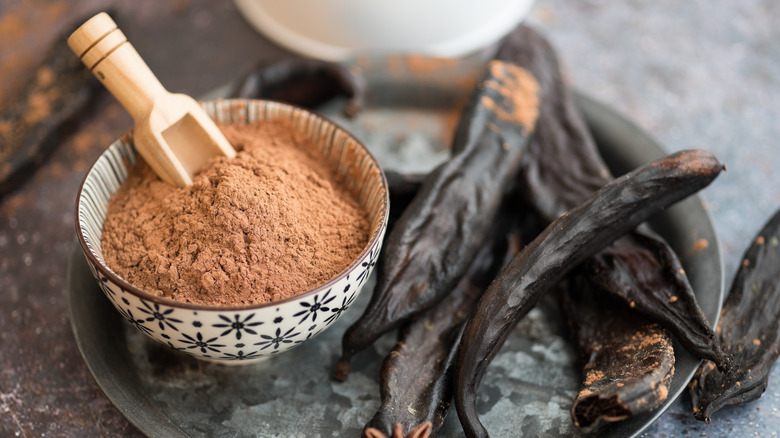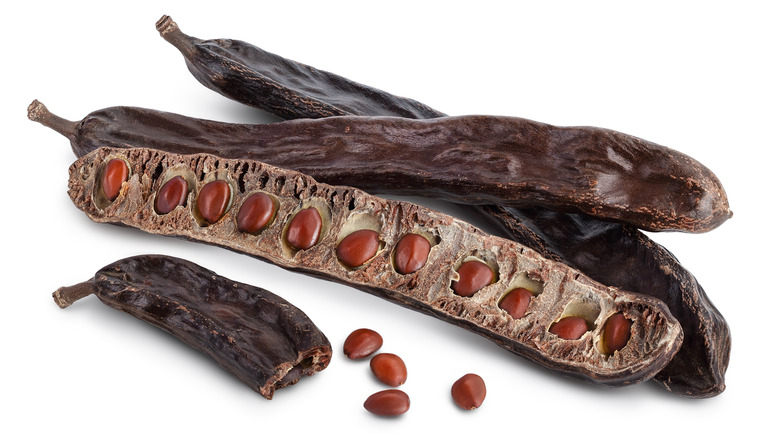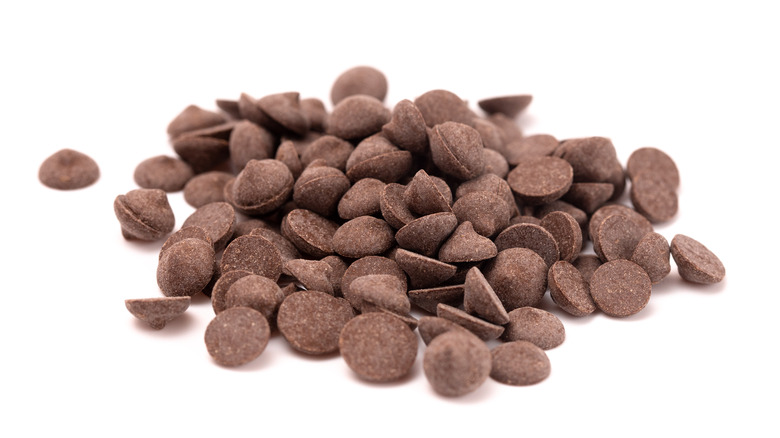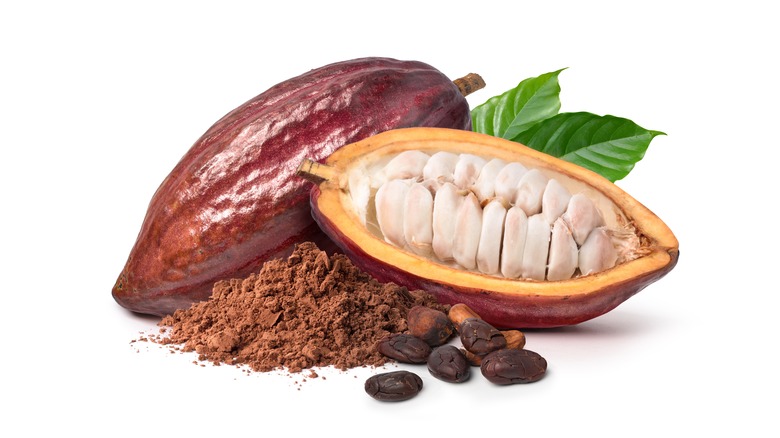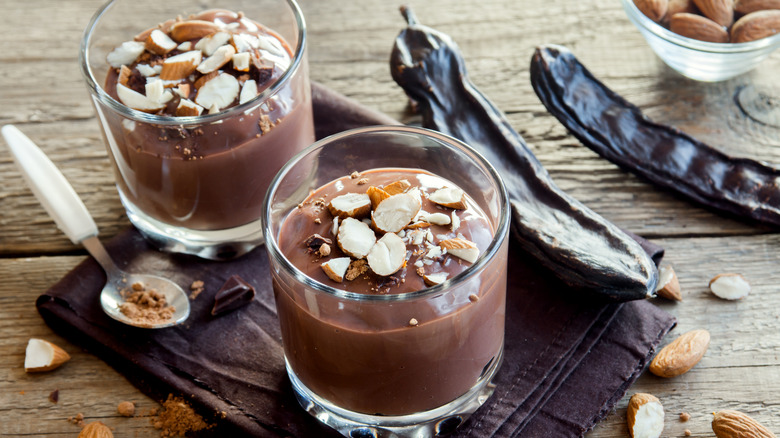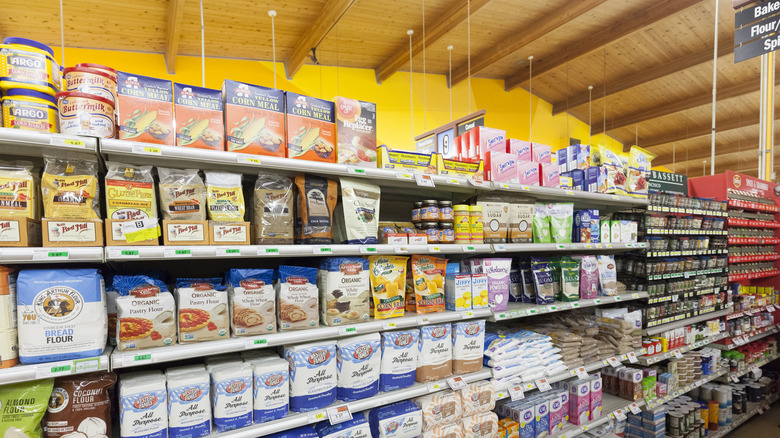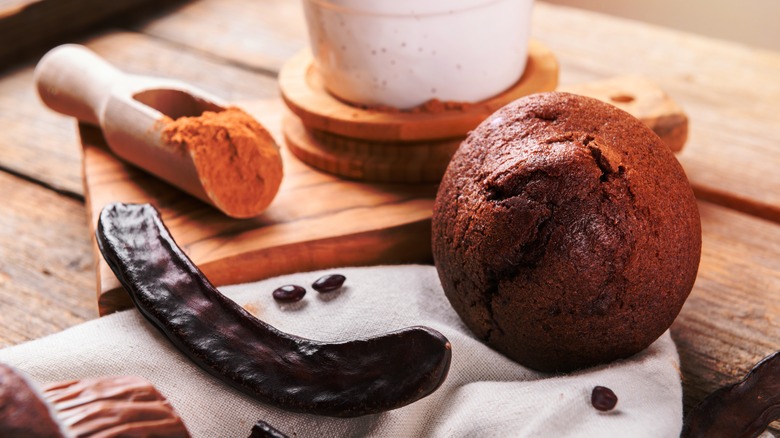Carob Is A Rich, Low-Sugar Ingredient Swap For Chocolate
If you've ever tasted baker's chocolate or tried a spoonful of cocoa powder, you probably immediately scrunched up your face and frantically reached for a glass of water. Chocolate, in its pure form, is extremely bitter. For this reason, sugar is added before it hits the shelves, and people dig into its bounty. Carob (Ceratonia siliqua) is sweet-tasting and sans the bitter bite, making additional sugar unnecessary — this makes it a rich substitute for chocolate.
Chocolate and carob have many similarities, from how they grow and where they come from to what they're used for. They both come from the pods of a tree and are roasted and ground into a fine powder. They have different levels of health benefits, each shining in their own unique areas. Of course, they make baked goods taste richer and sweeter and are a pretty even swap in recipes. Chocolate and carob also have quite a few differences, but both are worthy of a place in your pantry.
What is carob?
Carob is a member of the legume family and is also often referred to as the locust bean. Its pods are long and flat, resembling a large, brown, and leathery snow pea. The pods can grow up to 1 foot in length and just 1 inch across.
Carob has been around and consumed for thousands of years, dating back to ancient Greece, Italy, and the Middle East. As for the United States, production of this ingredient began in the 1800s. Currently, Portugal is the largest producer of carob worldwide, followed by Italy and Morocco. Carob boomed in popularity in the United States during the natural foods movement in the 1970s, when veganism and plant-based eating first sprouted onto the health scene. It became a health food store staple and darling of the food co-ops as a necessary baking basic.
Prior to its rise on the health scene, it was harvested as a crop for over a century in the U.S. but never quite took off in popularity or profitability. Due to the higher sugar content of the pods, some people used it in lieu of grains as farm feed to fatten up chickens and cattle. Today, it's used as a replacement for chocolate in cooking and baking for a myriad of reasons.
How is carob made?
Carob is made from the pulp in the fruit pods of the carob tree. To process carob, the edible pulp of the pods is harvested, dried, roasted, and then ground into a powder that ends up looking a lot like cocoa powder. The pulp is sweet in taste and does not need any added sugar or flavors to enhance it, unlike cocoa. The powder is sold as is or made into chips resembling chocolate chips and used in the same manner.
To transform carob powder into a chip, non-fat milk powder is added for flavor, and palm oil is used as a preservative. Sugar, or barley malt, is sometimes added as a sweetening agent, though the unsweetened varieties are sweet in their own right. Carob molassesis growing in popularity and is made by soaking the pods in water and reducing the liquid to a thick syrup, similar in viscosity to blackstrap molasses.
Does carob taste like chocolate?
In a nutshell, carob does not taste like chocolate. Just like cauliflower is a pretty conspicuous stand-in for white rice, anyone with taste buds would deduce carob is most definitely not chocolate. For this reason, it's often a pretty polarizing ingredient. However, when used in recipes with other ingredients, carob can be a suitable and tasty alternative to chocolate.
As a result of the roasting step in the process of making carob, it has a nutty, earthy flavor. It also has a natural sweetness to it and does not have a bitter aftertaste as unsweetened chocolate does. The bitterness of cacao, of which chocolate is made, requires adding sugar to counteract the harshness and give us the chocolate we know and love. Carob is much milder on the palate in this sense, and because of its inherent sweet taste, less sugar is needed in recipes. It's even been known to be used as a swap-in for sugar when necessary.
How to swap carob for chocolate
Carob is a straightforward substitute for chocolate, so in most recipes, it's a simple one-to-one swap. The main difference will be the lighter and nutty flavor that may not deliver the same taste that chocolate would, so keep that in mind when it comes to making the switch in certain recipes for baked treats like cookies, cakes, and muffins. But in general, carob chips can be used just as you would chocolate chips, and carob powder just as you would cocoa powder — you can just experiment with ratios depending on your preference.
With any chocolate-forward recipe, such as brownies, hot chocolate, or mousse, the differences on the palate will be notable, with carob adding a sweeter touch. In particular, carob molasses has a sweet, rich, caramelized flavor and can be used as a viscous topping over your favorite stack of pancakes or scoops of ice cream.
Where to buy carob
In its powder and chip forms, carob is widely available at health food stores and run-of-the-mill grocery stores and can typically be found in the baking aisle next to cocoa powder and chocolate chips. Both varieties are sometimes found in the bulk bins adjacent to the nuts and grains, but a sealed bag or carton is the better bet. Oftentimes it may sit for years in the bulk section, and there is no way to gauge its freshness, per The Vegan Atlas. You should store carob powder and chips the same way you would their chocolate counterparts — airtight and away from heat and moisture.
If your local grocery store doesn't carry it or it isn't in stock, a quick online search should help you find a variety of carob products. Stores like Uncommon Carob or Carobou carry a wide selection, from chips, bars, and dessert sauces that come in a range of flavors.
Nutritional information of carob
Another appeal of carob is that it is caffeine- and fat-free, so it's suitable for those who are watching their blood pressure, per Healthline and Thrive Market. It's a good source of B vitamins and vitamin A and has three times as much calcium as chocolate and fewer calories. It's also high in fiber, with 1 ounce offering up to 11 grams. And while carob is sweet in taste, it has a low glycemic index and won't cause a spike in blood sugar (via Glycemic Index Guide).
Carob is also a source of antioxidants, which may be helpful in preventing heart disease and lowering cholesterol levels. Carob may also aid with digestive issues and keep bad gut bacteria in check. In addition to having a leg-up over chocolate in being caffeine-free, carob is also dairy-free (whereas many chocolate chip varieties are not). It is also gluten-free and sans theobromine, which is a compound that may induce migraines in some people. All-in-all, it is a great option for those that are sensitive or mindful of certain health factors but still want to enjoy a chocolate-like treat.
